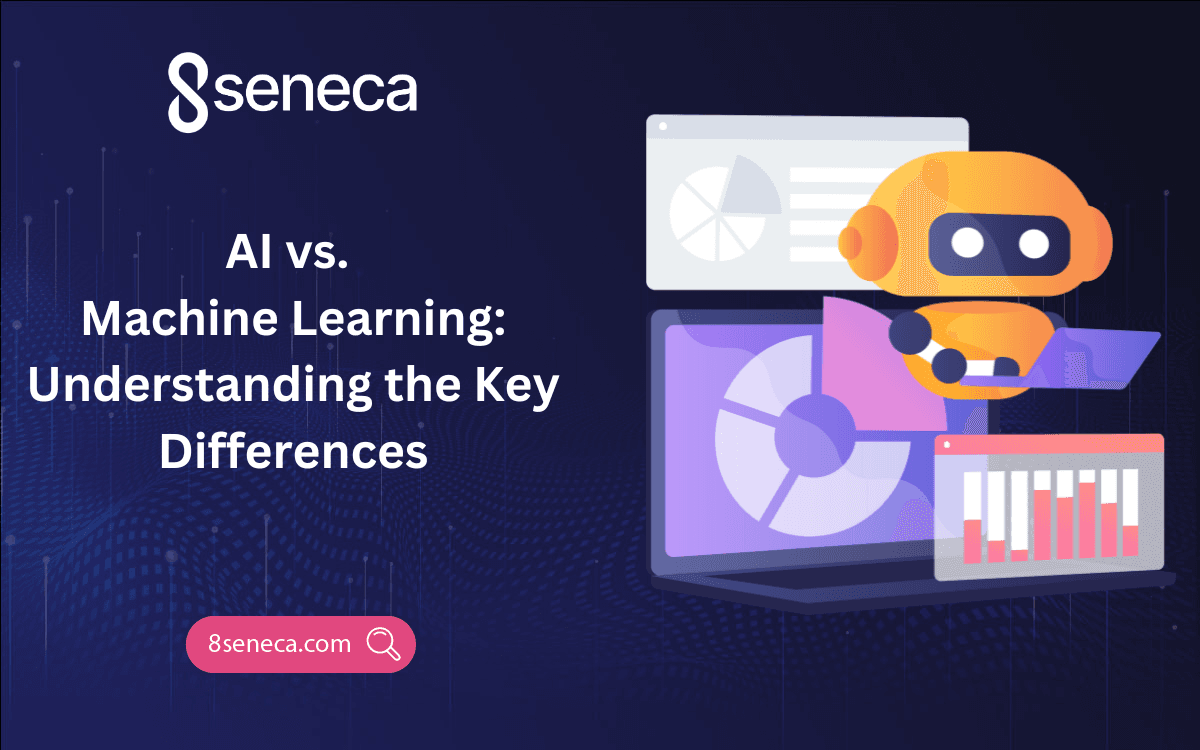Understanding Machine Learning in Modern Cybersecurity
Explore the role of machine learning in modern cybersecurity, highlighting its benefits, challenges, and applications.
In an era where cyber threats are growing in complexity and frequency, traditional cybersecurity measures are often insufficient. Machine learning (ML), a branch of artificial intelligence (AI) is transforming the cybersecurity landscape by providing advanced tools to detect, prevent and respond to cyber threats. Here’s an in-depth look at how machine learning is revolutionizing cybersecurity and benefits, challenges of adopting machine learning in cybersecurity.
What is Machine Learning?
Machine learning fundamentally involves training algorithms on large datasets to recognize patterns and make predictions. Typically, the process starts by collecting vast amounts of relevant data including network traffic logs, user behavior records and historical attack data. Then, engineers prepare the data, cleaning and structuring it to ensure quality and consistency. This step is crucial because the effectiveness of ML models is heavily reliant on the quality of the training data.
Following data preparation, the training phase begins, where the cleaned data is fed into an ML algorithm to create a model. This model learns to associate specific patterns with particular outcomes, such as identifying malware based on file characteristics. Subsequently, engineers validate the model by testing it on a separate dataset to evaluate its accuracy and performance. This ensures it can generalize its learning to new, unseen data. Once validated, they deploy the trained model in a real-world environment, where it can analyze live data and make predictions or take actions based on its training.
Traditional cybersecurity methods rely on predefined rules and signatures to detect threats. In contrast, ML models learn and adapt from new data. This makes them particularly effective against novel and sophisticated attacks.
Traditional cybersecurity methods are often static and rule-based, focusing on known threat signatures. This approach can fail against new or evolving threats. In contrast, ML models can analyze vast amounts of data to identify anomalies and potential threats in real-time. Moreover, these models continuously improves as they process more data.
Benefits of Adopting Machine Learning in Cybersecurity
Proactive Threat Detection
Machine learning enables proactive defense mechanisms by predicting and mitigating threats before they cause damage. Traditional methods often react to known threats while ML models can identify patterns and anomalies indicative of potential attacks, thus produces an anticipatory approach to cybersecurity.
Efficiency and Automation
ML automates many routine tasks in cybersecurity such as monitoring network traffic, analyzing logs and responding to low-level threats. This automation reduces the workload on security teams and allows them to focus on more complex and critical issues. For instance, ML can quickly classify and respond to malware, therefore significantly improve the efficiency of security operations.
Adaptability to New Threats
Unlike static rule-based systems, ML models continuously learn and adapt to new threats. This adaptability is particularly valuable in the face of evolving cyber threats such as zero-day exploits and advanced persistent threats (APTs). ML can recognize novel attack vectors by identifying suspicious patterns and behaviors that deviate from the norm.
Improved Accuracy and Reduced False Positives
ML models can achieve high accuracy in threat detection by analyzing large datasets and learning from past incidents. This capability reduces the number of false positives, which are benign activities mistakenly identified as malicious. By minimizing false positives, security teams can allocate their resources more effectively and avoid alert fatigue.
Comprehensive Threat Intelligence
Machine learning enhances threat intelligence by analyzing data from diverse sources including network logs, social media and dark web forums. This comprehensive analysis helps organizations stay ahead of emerging threats by identifying patterns and trends that may not be immediately apparent. Consequently, security teams can implement defensive measures before an attack occurs.
Challenges of Adopting Machine Learning in Cybersecurity
Data Quality and Quantity
One of the primary challenges in deploying ML models is the need for large, high-quality datasets. The performance of ML models heavily relies on the data they are trained on. Poor-quality data can lead to inaccurate predictions and ineffective threat detection. Collecting and curating relevant data from diverse sources is a significant undertaking that requires substantial resources and expertise.
Explainability and Transparency
ML models, particularly deep learning algorithms, are often considered “black boxes” because their decision-making processes are not easily interpretable. This lack of transparency can be problematic in cybersecurity, where understanding the rationale behind a model’s predictions is crucial for trust and accountability. Explainability is essential for regulatory compliance and for security teams to validate and act on the model’s insights.
Adversarial Attacks
Adversaries can exploit vulnerabilities in ML models through adversarial attacks, which involve manipulating input data to deceive the model. For example, attackers can subtly alter malware to evade detection by ML-based systems. Defending against such attacks requires ongoing research and development to enhance the robustness of ML models.
Resource Intensive
Developing, training and maintaining ML models require significant computational resources and expertise. Organizations must invest in the necessary infrastructure and skilled personnel to effectively implement and manage ML-based cybersecurity solutions. This can be a substantial barrier for smaller organizations with limited budgets.
Current Applications of Machine Learning in Cybersecurity
Some of the popular use cases for ML include:
Anomaly Detection
Anomaly detection is one of the most critical applications of ML in cybersecurity. Traditional rule-based systems often struggle to identify new or evolving threats. In contrast, ML models excel at recognizing deviations from normal behavior, which can indicate potential security incidents. By analyzing vast amounts of data, such as network traffic and user behavior logs, ML algorithms can detect unusual patterns that might signify a breach.
For example, an ML-based intrusion detection system (IDS) can monitor network activity and flag anomalies that suggest unauthorized access or data exfiltration. This approach is particularly effective in identifying zero-day attacks and insider threats, which traditional methods might miss.
Malware Detection
ML algorithms are extensively used for malware detection. Traditional antivirus solutions rely on known signatures to identify malicious files, which can be ineffective against new or obfuscated malware. ML models, however, analyze file attributes and behaviors to classify them as benign or malicious. This capability allows them to detect previously unknown malware by recognizing suspicious patterns.
For instance, static file analysis uses ML to predict a file’s maliciousness based on its features, while behavioral analysis examines how a file behaves at runtime. Combining these approaches, known as static and behavioral hybrid analysis, provides a robust defense against advanced threats.
Behavioral Analysis
Behavioral analysis involves monitoring the activities of users and entities within a network to detect deviations from established norms. ML models can learn what constitutes normal behavior for a user or system and flag any deviations as potential threats. This method is effective in identifying compromised accounts, insider threats and lateral movements within a network.
For example, an ML system might detect unusual login times, access patterns or data transfers that suggest a user’s credentials have been compromised. By continuously learning and adapting to new behaviors, ML can provide real-time alerts and responses to emerging threats.
Automated Threat Response
One of the significant advantages of ML in cybersecurity is its ability to automate threat detection and response processes. When an ML model identifies a threat, it can automatically take actions such as isolating affected systems, blocking malicious traffic or initiating incident response protocols. This automation reduces the time needed to respond to threats and minimizes the impact of potential breaches.
For example, an ML-based security information and event management (SIEM) system can automatically correlate events across different parts of an organization’s IT infrastructure and respond to detected threats in real-time. This reduces the workload on security teams and ensures faster mitigation of risks.
Vulnerability Management
ML models are also used in vulnerability management, where they help prioritize vulnerabilities based on their criticality and potential impact. By analyzing vast datasets of known vulnerabilities, past exploits and current threat intelligence, ML algorithms can recommend which vulnerabilities should be addressed first. This prioritization helps IT and security teams allocate resources more effectively and patch critical vulnerabilities before they can be exploited.
Incident Response
ML enhances incident response by automating the analysis of attack patterns and progression. Forensic analysis powered by ML can quickly identify the root cause of an incident, trace the attack’s path through the network, and suggest remediation steps. This automation accelerates the response time and reduces the potential damage from cyber incidents.
Conclusion
In conclusion, machine learning is revolutionizing cybersecurity by providing dynamic and adaptive defense mechanisms. Its ability to analyze vast amounts of data, identify complex patterns and automate responses makes it an essential tool in protecting against modern cyber threats. As cyber threats continue to evolve, the role of machine learning in cybersecurity will only become more critical.
8seneca offers customized B2B services, primarily in IT outsourcing. If you need assistance with IT outsourcing, please get in touch. We are actively recruiting for Junior Java Developers and AI Engineers to expand our team. For details on open roles, visit our recruitment center.
Related Articles

Jan 14, 2025
Read more
Will Decentralized Social Media Take Over in 2025?
Explore if decentralized social media could reshape online interactions in 2025 with greater privacy and control.

Jan 08, 2025
Read more
What You Need to Know About Zero-Trust Architecture
Learn the essentials of Zero-Trust Architecture: how it enhances cybersecurity by verifying every user and device.

Oct 07, 2024
Read more
Cloud Computing in Retail: Key Use Cases and Best Practices
Cloud computing helps retailers optimize operations, streamline inventory, and improve decision-making with real-time data.

Sep 27, 2024
Read more
How Hybrid Smart Contracts Revolutionize Blockchain Technology
Discover what hybrid smart contracts are and how they are revolutionizing blockchain technology, including key benefits and challenges.

Sep 25, 2024
Read more
AI vs. Machine Learning: Understanding the Key Differences
Learn the differences between AI and ML, their impact on business, and how to leverage them effectively in business.

Aug 14, 2024
Read more
Blockchain and the Future of Technology
Explore how blockchain technology is revolutionizing industries like finance, healthcare, and supply chain management.
